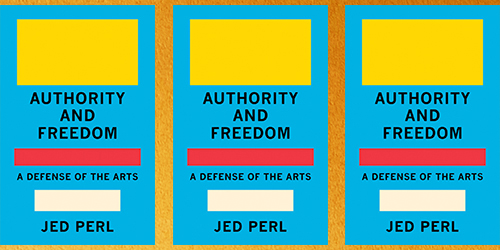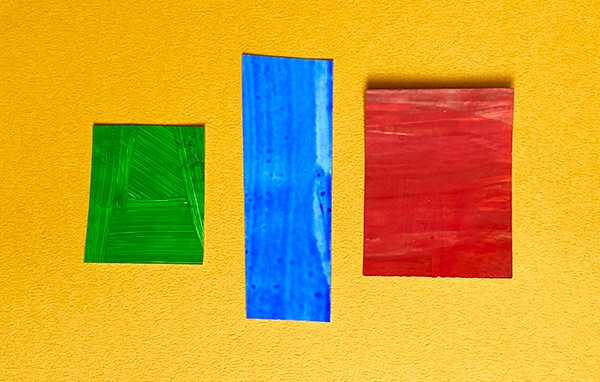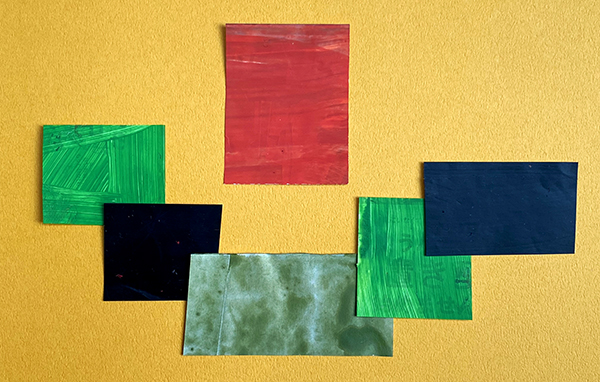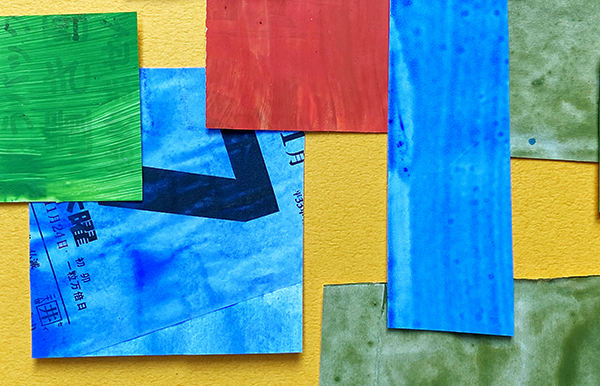
THE AMERICAN CRITIC EXAMINES A PUSH-AND-PULL DYNAMIC BETWEEN THE ESTABLISHED AND THE INNOVATIVE IN THE ARTS
by Edward M. Gómez
Chicken Little was not a conspiracy theorist.
“The sky is falling!” the prognosticating fowl proclaimed, based on the evidence of an acorn that had fallen on his head. Given all the destructive forces, both natural and human-generated, that are now threatening the planet, including the alarming rise of anti-democratic, fascist movements, that fabled worrywart’s cri de coeur does sound and feel like an appropriate slogan for our times.
In fact, it was against the backdrop of today’s deterioration of democracy in the U.S. — Donald Trump’s followers have been burning books in Tennessee and banning them in Texas; they’ve already suppressed voting rights in many states — that, at first, based on its title, I assumed the American critic Jed Perl had developed the ideas he presents in his new book, Authority and Freedom: A Defense of the Arts (Knopf).

Perl is well known as the former, longtime art critic for the New Republic; his essays also appear in the New York Review of Books, and he is the author of a sweeping, two-volume biography of the pioneering modernist sculptor Alexander Calder (Calder: The Conquest of Time: The Early Years: 1898-1940, which was published in 2017, and Calder: The Conquest of Space: The Later Years: 1940-1976, which came out in 2020; both books were published by Knopf).
Instead, as it turns out, the argument Authority and Freedom puts forth and the subject it addresses are more self-contained; they reside and can be examined neatly within the realm of aesthetics.
The authority to which Perl refers in his book’s title is not that of an oppressive government or totalitarian state, but rather that of the forms and traditions of art-making in different disciplines and genres that have long influenced and shaped them — the well-established, guiding, authoritative notions or principles that affect the structure or appearance of such familiar artistic creations as stories, paintings, or musical compositions.

In a recent interview about his new book, Perl told me, “More than fifteen years ago, I started giving lectures on the theme of authority and freedom. I had begun to feel that it wasn’t enough to write about the intense experiences that I had [myself] with works of art. I wanted to think about how my feelings about the arts related — and didn’t relate — to a broader social and political world. I wanted to get at the fundamental nature of artistic experiences — to explain why they are so powerful for so many people.”
The “freedom” in his new book’s title refers to the liberty or creative license any artist feels — and exercises — in developing and producing original works in relation to — and sometimes in defiance of — the so-called authority preserved in and codified by recognized masterworks or definitive forms of artistic expression in any particular discipline or genre.
Many such works might normally be referred to as “classics,” although Perl does not often use that label; instead, his investigation calls attention to the ways in which such diverse creations as Michelangelo’s 16th-century Laurentian Library in Florence, Virginia Woolf’s 1925 novel Mrs. Dalloway, Aretha Franklin’s soulful music (especially her 1972 gospel album Amazing Grace), or Piet Mondrian’s painting “Broadway Boogie-woogie,” from 1942-43, recognized and were shaped by the authority of the respective art forms they represent, even as they broke with some of their conventions to revamp, reject, or revolutionize them.

He writes, “Artists, however much they are shaped by their time and place and by the ideas and ideals that animate their age, must reshape experience. That’s their mandate. The reshaping, which turns experience into art, is both artisanal (a matter of mastering the tools of the trade, whether words, colors, shapes, sounds, or movements) and metaphysical (a never-ending competition between the rival claims of authority and freedom).”
Insofar as the kind of aesthetic authority and creative freedom Perl examines are, as he notes, “the lifeblood of the arts,” then “[w]hether reading a novel, looking at a painting, or listening to music, we are feeling the push and pull of these two forces as they shape the creator’s work. Authority is the ordering impulse. Freedom is the love of experiment and play. They coexist. They compete.”
Perl acknowledges that the arts have their own kind of internal logic or order, which is informed by the “authority” in which they are grounded and by which they are shaped. He suggests that, perhaps inevitably, works that might appear edgy or radical in one era, when they first appear, full of tradition-busting gusto, in time can and sometimes do become accepted emblems of the mainstream, exuding and embodying a certain authority of their own.
Consider, for example, Igor Stravinsky’s orchestral work The Rite of Spring and Vaslav Nijinsky’s choreography for its production by the Ballets Russes in Paris, in 1913; or Woolf’s or Gertrude Stein’s innovations with language in their novels; or any number of abstract works by modern artists who explored — and celebrated — the communicative power of pure form. Think, too, of free-form jazz, concrete poetry, conceptual art (that dispenses with physical art objects altogether), punk rock — all of these forms of artistic expression bucked the system and challenged the authority of their respective disciplines, but then, with the passage of time, ultimately became parts of the arts’ broader canon.

Perl notes that, sometimes, some forms of artistic expression may emerge out of a confrontation with authority in their particular disciplines and later become absorbed by the mainstream but still maintain their subversive-transgressive-innovative edge.
Think of Michelangelo’s Laurentian Library or Stravinsky’s groundbreaking, early-20th-century orchestral suites (The Firebird, Petrushka, The Rite of Spring), for example, which still look, feel, and sound as fresh, daring, and provocative today as they did when they were first unveiled or performed. Sometimes, today’s authority-challenging avant-garde can become tomorrow’s mainstream canon.
Authority and Freedom’s ruminations unfold, in large part, in the theoretical-conceptual, hermetic space of the work of art as a self-contained, art-for-art’s-sake phenomenon. But that’s not to say that Perl does not recognize that art forms of all kinds are informed and influenced by social, cultural, historical, or economic forces of the times and places in which they are created. He writes, “For the artist the medium is a world unto itself, but the struggle within the medium is also a way of coming to terms with the struggle between the possible and the impossible that plays out in the wider world.”
Movies, novels, plays, our favorite record albums — the arts certainly allow for what the modern British writer Graham Greene referred to as “ways of escape” from the hardships or banality of everyday life, and Perl acknowledges this most potent and appealing aspect of their value and allure.

In fact, sharing an observation about art from a creator’s point of view, Greene, who famously regarded his serious novels as distinctly separate from what he called his “entertainments,” noted in one of his autobiographical volumes, “Writing is a form of therapy; sometimes I wonder how all those who do not write, compose or paint can manage to escape the madness, the melancholia, the panic fear which is inherent in the human condition.”
As closely as Authority and Freedom examines the nature of artistic creativity from the art-maker’s position, it recognizes, too, that, “[b]efore an artistic experience is anything else, it’s often a critical element in a communal or social experience.” Perl writes, “In our time of social, economic, environmental, and political anxiety and unrest, many are asking whom the arts speak for. Do they speak for some particular group? Do they speak truth to power?”
For believers in the dictum that all art is somehow political in nature, or may be perceived and interpreted in certain political contexts, or may be made use of for political purposes, here, those themes are not Perl’s main concerns. In his compact new book’s succinct, lucid text, he writes:
“The idea of the work of art as an imaginative achievement to which the audience freely responds is now too often replaced by the assumption that a work of art should promote a particular idea or ideology, or perform some clearly defined civic or community service. Instead of art-as-art, we have art as a comrade-in-arms to some supposedly more stable or socially significant aspect of the world.”
This passage continues:
“Now art is all too often hyphenated. We have art-and-society, art-and-money, art-and-education, art-and-tourism, art-and-politics, art-and-protest, art-and-fun. Race, gender, and sexual orientation become decisive factors, often as a way of giving some readily comprehensible coordinates to the inherently uncategorizable nature of the artistic imagination. Given all the uncertainties that surround any creative endeavor, I can see why so many people want to link art to something else — something that can be more dependably defined.”

However “honorable,” as Perl puts it, they may be, such efforts to link art with certain issues or causes may end up as little more than “stopgap measures” — or perhaps exercises in propaganda; that’s my observation, not Perl’s — unless, as Authority and Freedom’s author writes, “they are grounded in an insistence that the products of the imagination have their own laws and logic.”
Above all, Perl’s book is an examination of art’s intrinsic, form-giving principles and energy, and of their ebb and flow in the art-making processes of artists from Mozart to Mondrian, whose inventiveness he highlights, and of their durability even in the face of inevitable evolution and change. (Bring on the avant-garde manifestos, the performers’ quirks that become signature styles, and the blue notes and breakthroughs that give art and cultural history its substance, reflecting artists’ creative visions and grit.)
In our recent interview, Perl noted, “My belief is that all important works of art — a novel, a painting, a symphony — compel us because we sense a creative artist engaging in a profoundly human debate between the force of a tradition (that of the novel, the painting, the symphony) and what the individual can do with that tradition. This debate has its own laws and logic — which stand apart from the social, economic, or political pressures we all feel.”

As noted above, I mistakenly misunderstood the meanings of the kinds of authority and freedom to which Perl refers in his book when I first noticed its title. Still, given today’s disturbing political developments in the United States, I asked him to weigh in on the current position of the arts here, given that his new, expanded essay argues so passionately for their inherent value for any healthy, dynamic society — not to mention the role they play in helping to nurture the spirit of democratic societies.
Perl observed, “We are living in a time that in many respects recalls the 1930s — a time, in other words, when the enormous political, social, and economic challenges that we’re facing push people’s thinking to extremes. And now — as in the 1930s — there is a danger that the arts can become vehicles for political and ideological grandstanding. In the 1930s, authoritarian regimes both on the Left and the Right wanted to use the arts for their own ends. Both in Stalin’s Russia and Hitler’s Germany, the arts became ideological tools. Great art can have an ideological import, but as Flannery O’Connor says in a letter that I quote in my book, you must make it a work of art first. In other words, the artist’s fundamental obligation is to the nature of art — and to finding his or her own sense of freedom within the authority of an art form.”
In our interview, Perl also noted, “What I’ve addressed in this book is the threat our hyper-politicized era, whether on the Right or the Left, poses to the ambiguities, paradoxes, and complexities that are the glory of the arts. The arts can’t be pinned down. Even when art has been commissioned for some specific purpose — religious or political — the greatest art (Michelangelo’s Sistine ceiling, Velázquez’s portraits of the Spanish royal family) eludes fixed definitions.”

“There’s a reason why there’s never any conclusion to the arguments about the politics of Shakespeare, Mozart, and Jane Austen. While you’ll find elements of social, political, and economic thought and feeling in their work, what they’re really involved with is an entirely different range of ideas, experiences, and emotions.”
Maybe the sky is not yet falling in, although some of us may see storm clouds gathering on the horizon. What comes across encouragingly and optimistically in Authority and Freedom are both Perl’s fascination with artistic creativity and his appreciation of the resonant impacts of the products of artists’ imaginations.
That’s an outlook that can only be rooted in a celebration of human inventiveness and our enduring need to express our aspirations, fears, desires, and fantasies, and to examine ourselves through the arts’ infinitely diverse forms.
As for Chicken Little, rumor has it that he has been listening to old Miles Davis and Patti Smith records, and has become an abstract expressionist.
Resources
Jed Perl, Authority and Freedom: A Defense of the Arts (Knopf)
ISBN 9780593320051
This new book can be ordered from its publisher, here.


